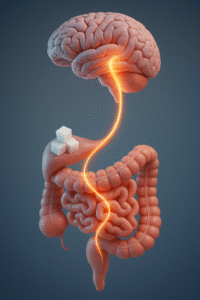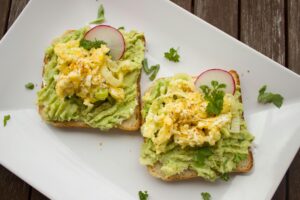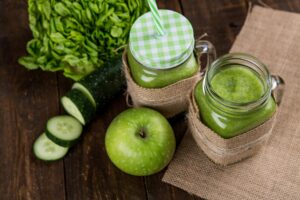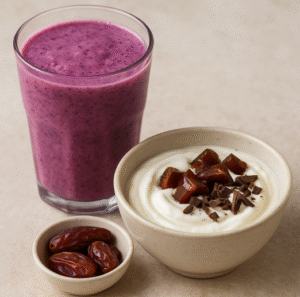Transform Your Brain’s Relationship with Sweetness for Lasting Change
Sugar cravings, those powerful and often overwhelming urges to consume something sweet, can feel insurmountable. If you find yourself frequently reaching for a biscuit, chocolate bar, or sugary snack, only to be left feeling hungry shortly after, you are certainly not alone in this struggle.
It is tempting to attribute this issue to a simple lack of willpower, but the reality is far more complex; it’s not your fault. Our biology predisposes us to desire sugar. For the majority of human existence, sweetness indicated energy and safety—a crucial advantage during periods of scarcity. However, in today’s society, this instinct has been exploited by the abundance of processed foods and concealed sugars that surround us.
 Contemporary diets often lack fibre and are excessively high in ultra-processed foods, resulting in a deficiency of vital nutrients. This unfortunate combination ensnares many individuals in a relentless cycle of cravings, energy crashes, and emotional eating.
Contemporary diets often lack fibre and are excessively high in ultra-processed foods, resulting in a deficiency of vital nutrients. This unfortunate combination ensnares many individuals in a relentless cycle of cravings, energy crashes, and emotional eating.
The encouraging news is that comprehending the science behind these cravings is the vital first step in liberating yourself from them. By understanding the profound impact of sugar on your brain chemistry, you will come to realise that this issue extends beyond simple willpower; it involves complex biology, ingrained habits, and emotional patterns that can be modified.
By making informed dietary choices, equipping your body with the necessary nutrients, and learning to sever the emotional connections to sugar, you can begin to rewire your brain’s response to sweetness. This journey is not about deprivation or restriction—it is about nourishing your body with what it truly requires and establishing new, healthier pathways in your brain that naturally diminish cravings.
Although this process does not yield immediate results, the right knowledge, tools, and support can empower you to reclaim control, become more attuned to your body’s needs, and enjoy food free from guilt or obsession.
Achieving liberation from sugar cravings is not merely an unattainable aspiration; it is a tangible reality that you can create. I am here to support you every step of the way.
The Deeper Reasons Behind Our Sugar Cravings
It is easy to assume that sugar cravings are solely about enjoying sweet flavours. After all, who doesn’t appreciate a sweet treat from time to time? However, there’s a much more profound narrative unfolding within your body.
Indeed, your taste buds contribute to this phenomenon. The receptors on your tongue detect sweetness and trigger feelings of pleasure. However, the true catalyst for intense sugar cravings lies in the gut-brain connection. This vital communication pathway sends potent signals between your gut and brain, influencing your desire for sugar.
The Gut-Brain Connection: Understanding Why Sugar Cravings Feel So Intense
 Here’s what occurs behind the scenes: specific neurons within your gut activate when you consume sugar. These cells are integral to a gut-brain circuit that connects directly to the brainstem via the vagus nerve, which serves as the primary communication channel between your gut and brain.
Here’s what occurs behind the scenes: specific neurons within your gut activate when you consume sugar. These cells are integral to a gut-brain circuit that connects directly to the brainstem via the vagus nerve, which serves as the primary communication channel between your gut and brain.
Interestingly, this pathway responds to real sugar but not to artificial sweeteners. This explains why diet drinks or sugar-free snacks often fail to satisfy cravings in the same way. They lack the profound biological feedback loop that genuine sugar triggers.
This gut-brain axis is what makes sugar cravings so compelling. It’s not solely about enjoying a sweet flavour; your brain receives signals that sugar equates to reward, pleasure, and safety. These primal instincts contributed to our survival during times of food scarcity.
Modern Diets: How They Exacerbate Sugar Cravings
However, modern dietary habits can worsen this issue. Consuming simple carbohydrates such as white bread and sugary snacks can trap your body in a state known as “sugar-burning mode.” This situation arises when your meals lack sufficient protein, fibre, and healthy fats, making it challenging to escape this cycle without making dietary changes.
This condition, referred to as metabolic inflexibility, indicates that your body relies heavily on sugar for energy while struggling to tap into stored fat for fuel. Consequently, you may find yourself feeling perpetually hungry, experiencing energy dips, and facing those intense cravings for quick sugar or carbohydrate fixes to keep you going. It’s not a personal failing; it’s a biological entrapment.
Sugar as Emotional Comfort: The Unseen Habit
 However, cravings extend beyond the physical realm.
However, cravings extend beyond the physical realm.
For many individuals, sugar serves as an emotional support system. We often turn to it to alleviate stress, elevate our mood, or reward ourselves after a long day. Over time, these behaviours become habitual. Thus, it’s not merely your body craving sugar; it’s your mind perceiving it as essential for emotional relief. This interplay of biological predisposition, blood sugar fluctuations, and emotional patterns creates a cycle that can seem unbreakable.
Awareness: The Essential First Step to Liberation
Recognising what is happening within your body is the crucial initial step. Once you understand that your cravings are not solely about taste or willpower but are influenced by a complex interplay of brain chemistry, gut health, metabolism, and emotional triggers, you can begin to implement effective changes.
You are not defective; your body is performing exactly as it has been conditioned to do. Yet, you possess the power to retrain it, and that is where genuine transformation begins.
Your Diet: A Powerful Ally in Overcoming Sugar Cravings
The great news is that your diet can serve as one of the most potent tools in combating sugar cravings. It is not merely a matter of eliminating sugar; rather, it is about incorporating the right foods and habits that fortify your body and brain.
By making intelligent food choices, you can help stabilise your blood sugar levels, maintain your energy, and train your body to depend less on quick sugar fixes. Let’s explore some of the most effective strategies:
Opt for Fruits to Alleviate Cravings
When a sugar craving strikes, turning to fruit can be your best strategy. Instead of succumbing to processed, high-calorie snacks, consider reaching for nature’s candy. Fruits are naturally sweet and loaded with fibre, vitamins, and water, making them far more satisfying than a biscuit or chocolate bar.
 Berries are an excellent choice due to their lower sugar content compared to other fruits while being higher in fibre. This characteristic aids in slowing digestion and prolonging feelings of fullness. Varieties such as strawberries, raspberries, and blueberries provide a sweet taste without causing significant blood sugar spikes. If your cravings are particularly strong, consider slightly sweeter fruits like mango, grapes, or pineapple. Pairing fruits with natural yoghurt or nuts can create a more satisfying snack, as protein and healthy fats help keep you satiated for longer.
Berries are an excellent choice due to their lower sugar content compared to other fruits while being higher in fibre. This characteristic aids in slowing digestion and prolonging feelings of fullness. Varieties such as strawberries, raspberries, and blueberries provide a sweet taste without causing significant blood sugar spikes. If your cravings are particularly strong, consider slightly sweeter fruits like mango, grapes, or pineapple. Pairing fruits with natural yoghurt or nuts can create a more satisfying snack, as protein and healthy fats help keep you satiated for longer.
Dried fruits such as dates and prunes are also excellent alternatives when you desire something sweet. They are rich in fibre, naturally sweet, and can provide satisfaction without resorting to processed sweets or chocolate. However, it is essential to remember that dried fruits are denser in sugar than their fresh counterparts. The drying process concentrates the sugar while reducing water content, making it easier to overindulge.
For example, consuming four dried fruits, like prunes, is much easier than eating four fresh plums. The high water content in fresh fruit helps you feel fuller more quickly, whereas dried fruit can be easy to overeat. When selecting dried fruit, be conscious of portion sizes. A modest serving can effectively satisfy a sweet craving, but larger quantities can quickly escalate in sugar and calorie content.
Combining dried fruit with a source of protein or healthy fats, such as a handful of nuts, can help slow sugar absorption and maintain feelings of fullness. Alternatively, you could drink a glass of water alongside your snack to enhance hydration and satiety.
Make Protein a Priority
 Incorporating protein into your diet serves as a formidable strategy against cravings. Consuming protein-rich foods such as eggs, chicken, fish, lentils, or tofu keeps you feeling satiated for longer periods. This is because protein slows down digestion and influences your hunger hormones, reducing levels of ghrelin—the hormone that signals hunger—and increasing hormones like PYY and GLP-1, which signal fullness to your brain.
Incorporating protein into your diet serves as a formidable strategy against cravings. Consuming protein-rich foods such as eggs, chicken, fish, lentils, or tofu keeps you feeling satiated for longer periods. This is because protein slows down digestion and influences your hunger hormones, reducing levels of ghrelin—the hormone that signals hunger—and increasing hormones like PYY and GLP-1, which signal fullness to your brain.
Research indicates that a high-protein breakfast, including foods such as eggs or Greek yoghurt, can lower hunger and cravings throughout the day. This means you are less likely to crave sugary snacks during mid-morning or afternoon slumps. Plant-based proteins, including lentils, beans, and chickpeas, also contribute positively to this effort. They provide a consistent source of energy without the blood sugar fluctuations associated with refined carbohydrates.
Incorporate Plenty of Fibre into Your Meals
Fibre is an essential ally in managing cravings effectively. Foods that are high in fibre slow digestion, helping you to feel full for extended periods. These include whole grains, lentils, beans, chia seeds, and a variety of vegetables.
Soluble fibre found in chia seeds and oats absorbs water and expands in your gastrointestinal tract, creating a sensation of fullness that can last for hours. This leads to fewer hunger pangs and a reduced urge to snack on sugary foods. Whole grains and vegetables also add volume to your meals, providing satisfaction without needing additional calories from sugar.
Address Sweet Cravings with Nutrient-Dense Foods
At times, cravings arise because your body signals a need for more food, not solely sugar. Incorporating naturally sweet, nutrient-rich foods such as sweet potatoes can significantly impact your cravings. Sweet potatoes offer natural sweetness, fibre, and slow-release carbohydrates, along with essential vitamins like A and C. Including healthy carbohydrates like sweet potatoes or butternut squash in your meals helps you feel nourished and satisfied, thereby diminishing the temptation for sugary snacks later.
Select Satisfying Snacks
 When cravings emerge, having healthy snack options readily available can be a game-changer. Greek yoghurt, in particular, is an excellent choice due to its high protein content, calcium richness, and benefits for gut health—especially if it contains live cultures. Opt for plain yoghurt without added sugars and enhance it with berries or a drizzle of honey if you desire a hint of sweetness.
When cravings emerge, having healthy snack options readily available can be a game-changer. Greek yoghurt, in particular, is an excellent choice due to its high protein content, calcium richness, and benefits for gut health—especially if it contains live cultures. Opt for plain yoghurt without added sugars and enhance it with berries or a drizzle of honey if you desire a hint of sweetness.
Trail mix serves as another fantastic option. A combination of dried fruit and nuts provides the best of both worlds: natural sweetness from the fruit and healthy fats, protein, and fibre from the nuts. Remember to monitor portion sizes, as a small handful is sufficient since nuts are calorie-dense.
Make Thoughtful Substitutions
You don’t have to forgo everything you enjoy.
If you find yourself craving chocolate, consider switching to dark chocolate—70% cocoa or higher. It contains less sugar than milk or white chocolate while being abundant in antioxidants that benefit both your heart and brain. Just remember that moderation is essential.
For fans of fizzy drinks, consider opting for sugar-free sodas. Artificial sweeteners can provide a sweet taste without actual sugar. However, be cautious, as studies indicate that in the long term, they may not effectively reduce cravings. Some research suggests they might heighten the desire for sweetness, so it’s advisable to use them sparingly.
Chewing sugar-free gum or sucking on mints can also provide a sweet taste without significantly adding to your calorie intake. These can be practical tools for breaking the habit of reaching for sugary snacks.
Prioritise Gut Health for Better Craving Control
Your gut and brain are in constant communication, and the health of your gut can significantly impact your cravings.
Fermented foods such as kimchi, sauerkraut, kefir, and kombucha are rich in beneficial bacteria that support your gut microbiome. A healthy gut can help regulate your appetite, enhance digestion, and potentially diminish cravings for processed sugary foods.
By nourishing your gut with the right foods, you can provide your brain with better signals, helping to mitigate intense sugar cravings.
Utilise Smoothies as a Healthy Snack Option
 Smoothies can serve as an excellent alternative to sugary snacks or fizzy beverages. Blending whole fruits with yoghurt or milk provides you with natural sweetness, fibre, and essential nutrients.
Smoothies can serve as an excellent alternative to sugary snacks or fizzy beverages. Blending whole fruits with yoghurt or milk provides you with natural sweetness, fibre, and essential nutrients.
The secret lies in using whole fruit instead of juice, as whole fruit retains its fibre, which slows sugar absorption and enhances feelings of fullness. Adding protein, such as Greek yoghurt or protein powder, makes for a more satisfying snack. Including healthy fats like nut butter or chia seeds helps maintain energy levels and prolong fullness.
The Importance of Eating Patterns in Managing Cravings
While it’s easy to focus on what you eat, when and how you eat is equally critical, particularly in managing sugar cravings.
Your eating habits shape your energy levels, mood, and hunger signals throughout the day. Prolonged periods without food can lead to blood sugar drops, elevating hunger hormones and triggering your brain to seek out quick fixes, often in the form of sugary or fatty foods.
This is why establishing a routine that promotes steady energy and curbs cravings is vital.
How Regular Eating Habits Can Help Break the Sugar Craving Cycle
A straightforward yet effective strategy is to maintain regular eating intervals. Aim to eat every 3 to 5 hours to keep your energy levels stable. When you wait too long between meals, your blood sugar plummets, leading to irritability, fatigue, and an increased likelihood of reaching for quick, sugary snacks. These choices provide a temporary energy spike but result in a subsequent crash.
Regular eating helps to stabilise blood sugar levels, regulate hunger hormones such as ghrelin, and mitigate the risk of impulsive, emotional eating. For each meal or snack, incorporate protein- and fibre-rich foods to help you feel full for longer and provide sustained energy. Consider options like eggs, chicken, lentils, Greek yoghurt, or nuts paired with vegetables, whole grains, or fruit.
If large meals are not your preference, that is perfectly fine. You can also opt for smaller, more frequent portions. For instance, three main meals accompanied by two planned snacks can work effectively. The key is in planning to ensure you are not left in situations where you feel famished, leading to hasty food choices.
Combine Foods to Satisfy Your Cravings
If you choose to indulge in a treat, consider how to make it work for you rather than against you. Pairing sweet treats with healthier foods can stabilise blood sugar levels, helping you feel satisfied for a longer duration and reducing cravings.
For example, if you are craving chocolate, try dipping banana slices in melted dark chocolate. Bananas provide natural sweetness and fibre, while dark chocolate satisfies your cravings with less sugar and offers antioxidant benefits.
Alternatively, combine a small handful of almonds with a few chocolate chips. The almonds offer protein, healthy fats, and fibre, which slow the absorption of sugar from the chocolate. This way, you can enjoy a sweet snack without experiencing a significant blood sugar surge and crash.
This approach is not about deceiving yourself; it’s about making your cravings work in your favour. By combining sweet treats with nutrient-dense foods, you provide your body with what it needs to maintain balance while still relishing an indulgent experience.
 You can also experiment with additional combinations:
You can also experiment with additional combinations:
- Apple slices with nut butter drizzled with honey
- Greek yoghurt topped with chopped dates or dark chocolate shavings
- Blended frozen berries with a splash of milk and a teaspoon of cocoa powder
These combinations help satisfy your sweet cravings in a more balanced and nourishing manner. Over time, this approach can also assist in retraining your taste buds and lessening the intensity of your sugar cravings.
Prioritise Early Caloric Intake (Front-Load Your Daily Calories)
Many individuals inadvertently consume the bulk of their calories later in the day, often resulting in late-night snacking and sugar cravings.
Consider adjusting your eating pattern to include more calories and nutrients earlier in the day. A solid, balanced breakfast and substantial lunch can help stabilise blood sugar levels and reduce cravings in the evening. This approach supports your natural circadian rhythms and can enhance energy, mood, and appetite regulation.
How Distributing Protein Throughout the Day Can Alleviate Sugar Cravings
It’s not solely about the total amount of protein consumed daily; it’s equally important to distribute it consistently across your meals. Incorporate protein sources such as eggs, yoghurt, lentils, fish, or chicken into every meal and snack. Protein helps to regulate blood sugar levels, keeps you satisfied longer, and diminishes cravings.
Finish Eating at Least 2–3 Hours Before Sleep (Align Your Eating with Circadian Rhythms)
Consuming food too close to bedtime can disrupt both sleep and digestion, often leaving you feeling lethargic and craving sugar upon waking.
Concluding your last meal 2–3 hours before sleep creates a gentle fasting period that can enhance sleep quality, support gut health, and curtail late-night snacking.
Focus on Balanced Meals (Harness the Power of the Three-Macro Plate)
Aim to include protein, fibre-rich carbohydrates, and healthy fats in each of your meals. This combination slows digestion, stabilises blood sugar, and reduces cravings.
For instance:
- Grilled chicken (protein) + quinoa (fibre-rich carb) + avocado (healthy fat)
- Lentil soup (protein & fibre) + wholegrain bread (carb) + drizzle of olive oil (fat)
Avoid Grazing and Mindless Snacking
While small, planned snacks can aid in managing hunger, incessant grazing on refined carbohydrates or sugary snacks leads to blood sugar spikes. These fluctuations make you feel tired, irritable, and hungry for more sugar. It is all too easy to eat out of habit or boredom.
Instead, focus on eating mindfully at designated times. Choose balanced meals and snacks that allow your body adequate time to digest and reset. This practice promotes stable blood sugar levels and retrains your natural hunger and fullness cues.
 Stay Hydrated for Better Control Over Cravings
Stay Hydrated for Better Control Over Cravings
Many individuals confuse thirst with hunger, leading to unnecessary snacking and cravings for sugar. Before reaching for a snack, pause and ask yourself whether you are genuinely thirsty. Drinking a glass of water or herbal tea can be beneficial.
Proper hydration supports your body’s natural signals and can help to alleviate cravings, preventing you from resorting to sugar as an immediate solution. Staying well-hydrated is a simple yet effective practice for managing sugar cravings.
Pause and Reflect Before Eating
Taking a brief pause, even for 30 seconds, before consuming food allows you to check in with your body. Are you genuinely hungry, or are you eating out of boredom, stress, or habit? This small practice builds awareness and encourages more intentional choices.
Eating patterns should not be perceived as rigid rules, but rather as a commitment to consistency and balance. Sugar cravings tend to diminish when you eat regularly and make mindful food selections, reducing the likelihood of falling into the craving trap.
Rewiring Your Response to Sugar: Steps Towards Lasting Change
Consistently applying these dietary strategies can assist in reprogramming how your body and brain respond to sugar. Regular meals rich in protein and fibre enable your body to become more metabolically adaptable, learning to utilise fat for energy instead of relying on quick sugar bursts. Opting for naturally sweet, nutrient-dense foods satisfies cravings while providing essential fibre and nutrients, helping to prevent the intense craving cycle associated with refined sugars. Moreover, supporting gut health through diet may positively affect the gut-brain signals related to cravings.
Embarking on Your Journey to Freedom from Sugar Cravings
Breaking free from sugar cravings involves more than merely exercising willpower or frequently saying “no.” It requires working in harmony with your body rather than against it. Your biology, brain, and emotions play significant roles in how you react to sweetness.
Comprehending that sugar cravings arise from gut-brain signals, blood sugar fluctuations, and habitual behaviours alleviates some of the pressure. It is not a matter of willpower; it is biology at work. This understanding removes the notion of personal failure—it is a natural, biological response. Recognising this empowers you to take action.
Making informed nutritional choices equips your body with what it genuinely needs. By incorporating protein and fibre, eating regularly, and nurturing your gut health, you can effectively manage cravings. Furthermore, you can discover balanced ways to indulge your sweet tooth. Over time, these small, consistent actions will gradually rewire your brain’s response to sweetness.
Perfection is not the goal; progress is what matters. Each healthier choice you make strengthens a new neural pathway in your brain, paving the way towards liberation from the grip of sugar. Change requires time, and you may experience setbacks along the way. However, by practising these strategies, remaining curious, and extending kindness to yourself, you can transform your relationship with food.
This is how you can break the cycle for good. You are not merely reducing sugar intake; you are crafting a healthier, balanced lifestyle where you feel in control, energised, and able to enjoy sweetness in a manner that supports your body rather than sabotages it. And that is a transformation worth pursuing.
The Article: Break Free From Sugar Cravings appeared first on https://janestevensnutrition.com